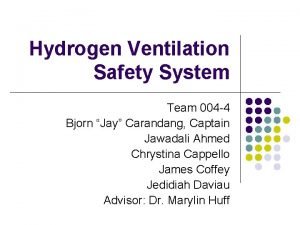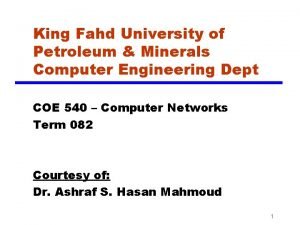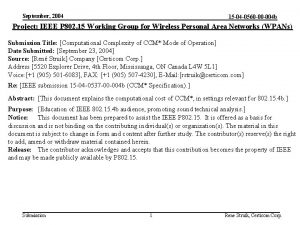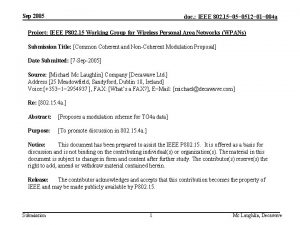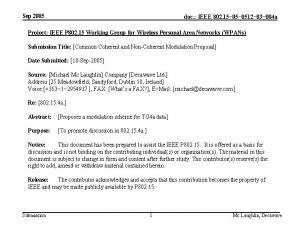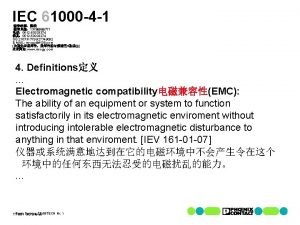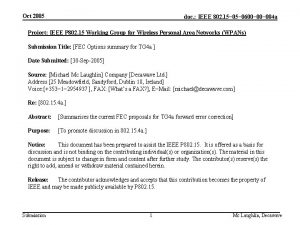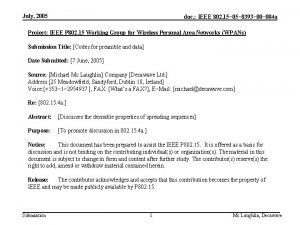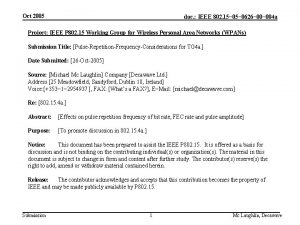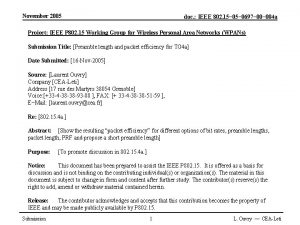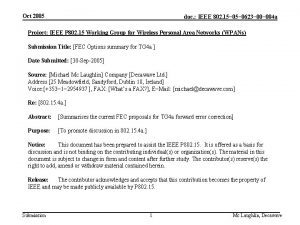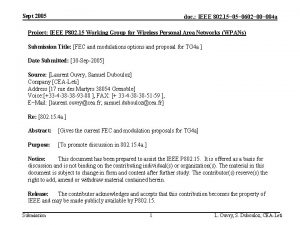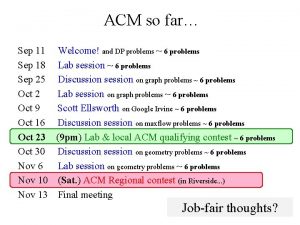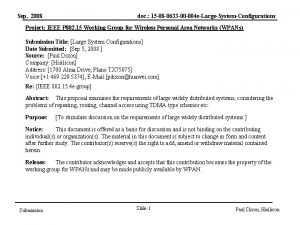Sep 2005 doc IEEE 802 15 0512 004















- Slides: 15

Sep 2005 doc. : IEEE 802. 15− 0512− 004 a Project: IEEE P 802. 15 Working Group for Wireless Personal Area Networks (WPANs) Submission Title: [Common Coherent and Non-Coherent Modulation Proposal] Date Submitted: [18 -Sep-2005] Source: [Michael Mc Laughlin] Company [Decawave Ltd. ] Address [25 Meadowfield, Sandyford, Dublin 18, Ireland] Voice: [+353− 1− 2954937 ], FAX: [What’s a FAX? ], E−Mail: [michael@decawave. com] Re: [802. 15. 4 a. ] Abstract: [Proposes a modulation scheme for TG 4 a data] Purpose: [To promote discussion in 802. 15. 4 a. ] Notice: This document has been prepared to assist the IEEE P 802. 15. It is offered as a basis for discussion and is not binding on the contributing individual(s) or organization(s). The material in this document is subject to change in form and content after further study. The contributor(s) reserve(s) the right to add, amend or withdraw material contained herein. Release: The contributor acknowledges and accepts that this contribution becomes the property of IEEE and may be made publicly available by P 802. 15. Submission 1 Mc Laughlin, Decawave

Sep 2005 doc. : IEEE 802. 15− 0512− 004 a Option 1 Proposal ~1000 ns Submission ~1000 ns 2 Mc Laughlin, Decawave

Sep 2005 doc. : IEEE 802. 15− 0512− 004 a Option 10 Proposal ~1000 ns Submission 3 Mc Laughlin, Decawave

Sep 2005 doc. : IEEE 802. 15− 0512− 004 a Option 1: Antipodal 4 pt Constellation bit 1 bit 0 Symbol Transmitted 0 0 -1. . 1 0 1 -1. . -1 1 0 1. . -1. . 1 1. . -1 Hamming distance = 1 and SED = d Antipodal and 2 bits different 01 11 00 Hamming distance = 2 and SED =2 d 10 Antipodal and 2 bits different SED = Squared Euclidean Distance Orthogonal and 1 bit different Submission 4 Mc Laughlin, Decawave

Sep 2005 doc. : IEEE 802. 15− 0512− 004 a Option 1: Equivalent Antipodal 4 pt bit 1 bit 0 Symbol Transmitted 0 0 -1. . 0 0 1 0. . 1. . -1 1 0 0. . -1. . 1 1. . -1. . 0 Antipodal and 2 bits different Hamming distance = 1 and SED = d 01 11 Antipodal and 2 bits different 00 10 Hamming distance = 2 and SED =2 d SED = Squared Euclidean Distance Orthogonal and 1 bit different Submission 5 Mc Laughlin, Decawave

Sep 2005 doc. : IEEE 802. 15− 0512− 004 a Non-Antipodal 4 pt Constellation Hamming distance = 2 but SED = d bit 1 bit 0 Symbol Transmitted 0 0 -1. . 0 0 1 1. . -1. . 0 1 0 0. . -1. . 1 1 1 0. . 1. . -1 Orthogonal and 2 bits different 11 01 00 10 Antipodal and 1 bit different Hamming distance = 1 but SED =2 d SED = Squared Euclidean Distance Submission 6 Mc Laughlin, Decawave

Sep 2005 doc. : IEEE 802. 15− 0512− 004 a Trellis Diagram, Optimum antipodal conv. code with g 1=35, g 2=23 dfree = 7, with 2 parallel pathways This is the way this code is supposed to work! Submission 7 Mc Laughlin, Decawave

Sep 2005 doc. : IEEE 802. 15− 0512− 004 a Trellis Diagram, Non-Antipodal g 1=35, g 2=23 dfree = 5, 1 pathway This is how it actually works with the PPM/BPSK constellation! Submission 8 Mc Laughlin, Decawave

Sep 2005 doc. : IEEE 802. 15− 0512− 004 a Trellis Diagram, Non-Antipodal g 1=35, g 2=16 dfree = 7, 2 parallel pathways This is a better code with the PPM/BPSK constellation! Submission 9 Mc Laughlin, Decawave

Sep 2005 doc. : IEEE 802. 15− 0512− 004 a Trellis Diagram, Non-Antipodal g 1=33, g 2=02 dfree = 7, 2 parallel pathways This is just as good too and its systematic! Submission 10 Mc Laughlin, Decawave

Sep 2005 doc. : IEEE 802. 15− 0512− 004 a Coherent AWGN PER k=5, various conv. codes Seems as if (35, 16) has slight PER advantage but the systematic code (33, 02) makes things easier all round Submission 11 Mc Laughlin, Decawave

Sep 2005 doc. : IEEE 802. 15− 0512− 004 a Coherent vs Non-Coherent AWGN PER At 1 Mbps required Eb/No of 12 d. B means shorter non-coherent range. Range increases as bit rate decreases. 7 m for 1 Mbps => 50 m for 20 kbps Submission 12 Mc Laughlin, Decawave

Sep 2005 doc. : IEEE 802. 15− 0512− 004 a Proposed Option 10 XOR Pos’n Sign Symbol Transmitted 0 0 -1. . 0 0 1 1. . -1. . 0 1 0 0. . -1. . 1 1 1 0. . 1. . -1 data in Sign Pos’n Coded data out Note: Can recover Pos’n bit with non-coherent receiver architecture. Exact code composition TBD Submission Figure 7. Convolutional code. Rate ½ code, K=5, Generators (33, 02), g 1=11011, g 2=00010 13 Mc Laughlin, Decawave

Sep 2005 doc. : IEEE 802. 15− 0512− 004 a Recommendation • Option 10 Summary – Combined PPM and BPSK for both coherent and non-coherent modulation at all PRFs. – K=5 convolutional code with octal generators (33, 02) for sign and position respectively Submission 14 Mc Laughlin, Decawave

Sep 2005 doc. : IEEE 802. 15− 0512− 004 a Advantages • Non-coherent can decode also – Don’t need a common lower performance mode to accomodate non-coherent receiver • No Price to Pay for Coherent – Optimal AWGN BER performance for coherent architecture - same as Option I and II. • Coherent may turn off its Viterbi decoder – systematic code makes this easy – If signal good enough, (lose ~8 d. Bs) – lower power consumption Submission 15 Mc Laughlin, Decawave












